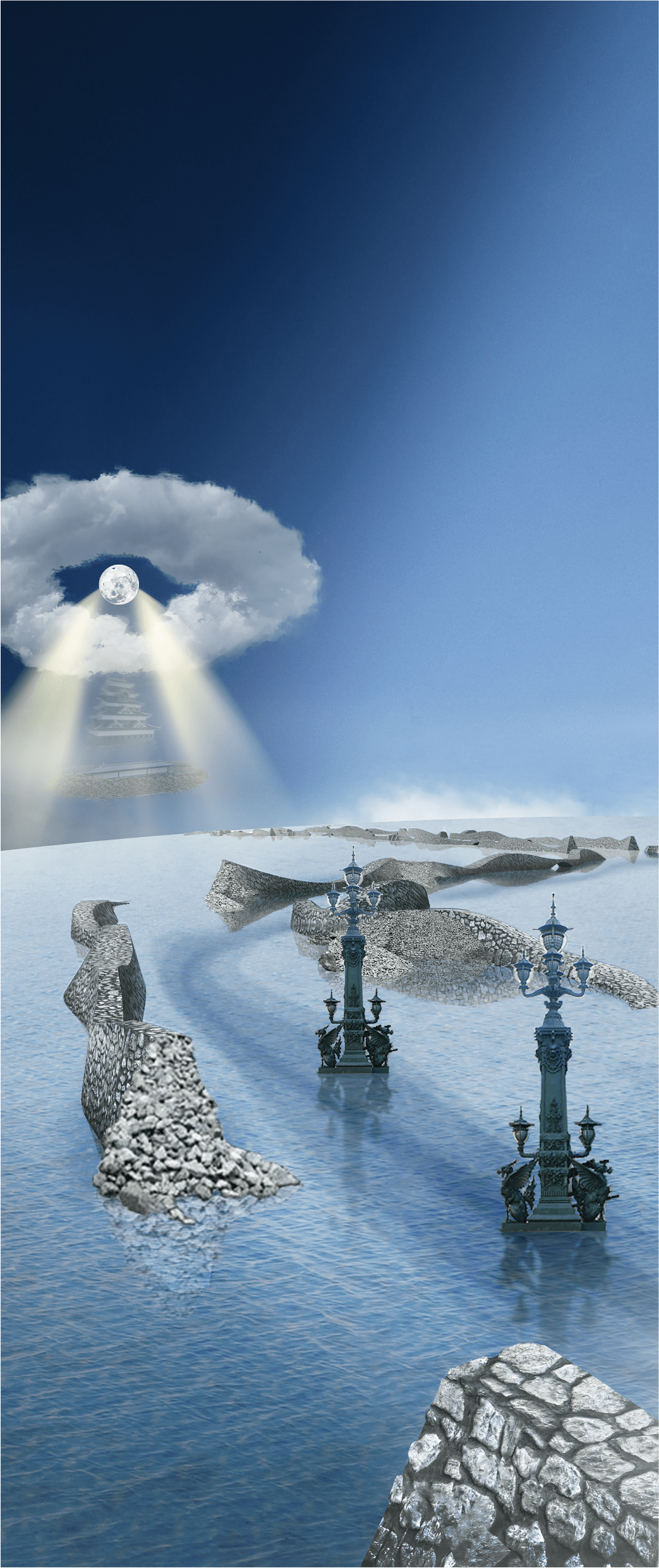
Drawing "300 years Infrastructure"
ドローイング「300年のインフラストラクチャー」
ドローイング「300年のインフラストラクチャー」
Tokyo has existed for 150 years since Edo Castle was burned down.
If you travel through the Sotobori (outer moat of Edo Castle) with the boat, you will notice the Ishigaki (stone wall) of Edo Castle remains in several spots.
They are hidden underground area from the coast, and many citizens of Tokyo remain unaware of their existence.
Ishigaki will continue to be here in 150 or 300 years, even if no one knows, even after various buildings has been taken down.
What’s more, the Ishigaki will still exist in the memories of those who used to live on the Sotobori River in the boat.
江戸城の焼失から約150年の月日を東京は生きてきた。
外濠を小舟でめぐると、江戸城の石垣が点々と残っていることに気付かされる。
これらは沿岸からは地面の下に隠れて、街往く多くの人はその存在を知らないままである。
あらゆる建築物が滅びても、誰も知ることがなくても、150年、300年後もこの場所に石垣は在り続けるだろう。
かつてこの外濠航路を船で往った人々の記憶が石垣を廃墟として遺すのである。
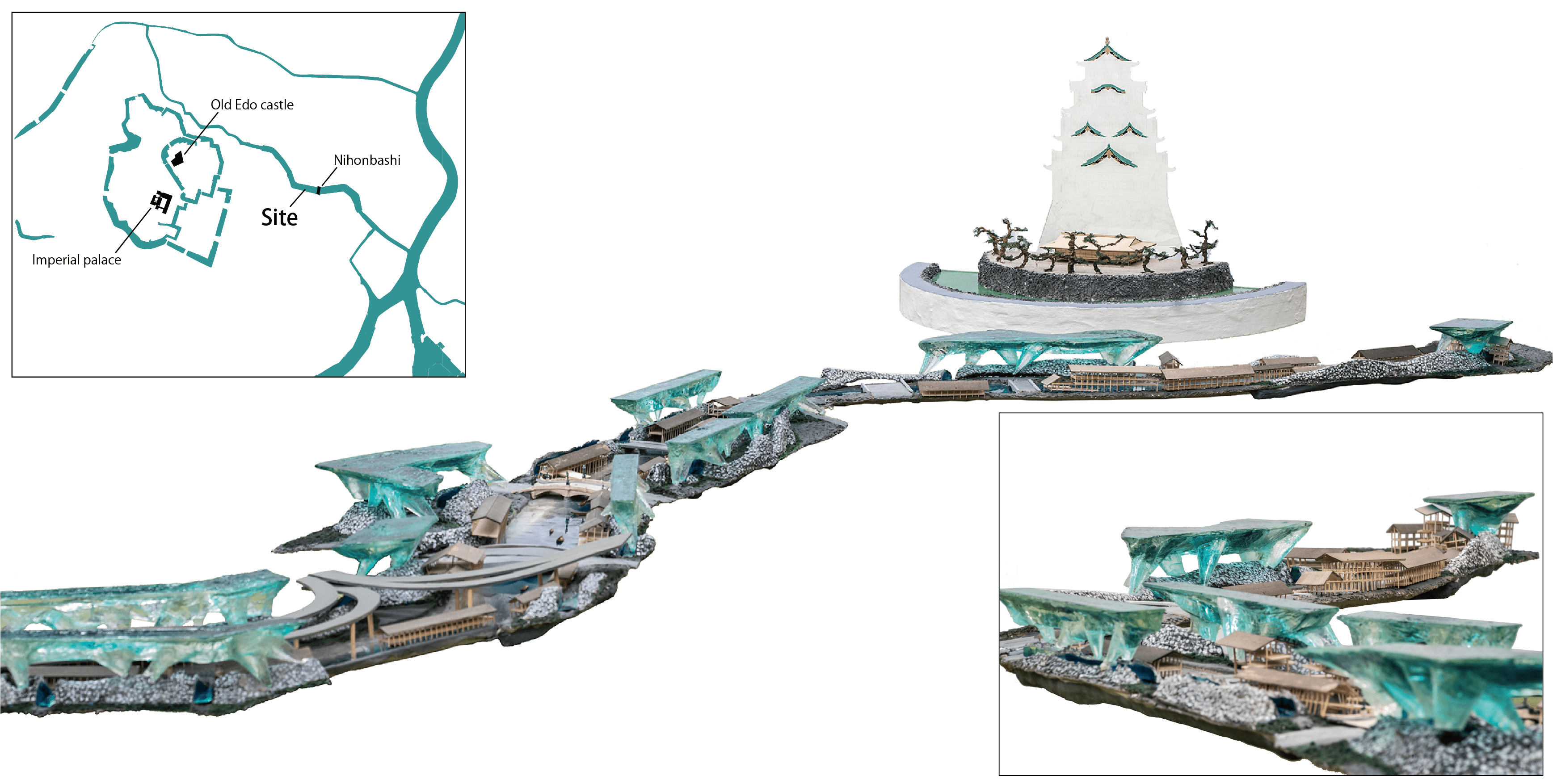
”Master plan of Soto-bori in Tokyo”
The design of the environmental infrastructure, such as water and wind, restores the vista to the Imperial Palace (Edo Castle), which was formed by the outer moat of Edo Castle.
”外濠のマスタープラン”
水、風といった環境インフラのデザインが、江戸城外濠が成していた皇居(江戸城)へのヴィスタを復元する。
The Sotobori of Edo Castle served as three kinds of infrastructures, City defense, Environment (water and wind tunnel), and Logistics.
Even now, when you live on the Sotobori River on the boat, you can feel the temperature on it is a few degrees cooler than the temperature on the ground.
As Tokyo metropolitan Expressway will be partially transferred undergrounded after the 2020 Olympics, the primary issue for Tokyo should be recovering urban environment.
For that purpose, we proposed a reforming project of the riversides of Sotobori, which last for 2km long, as an environmental infrastructure.
The core conception of the project is to redesign the water of Sotobori itself.
It is not well known that the riverbed of the Sotobori is soil since the Edo period instead of concrete. The project begins with the plan to use the small dredger, which can approach to Sotobori from the Tokyo port with the present water level of Sotobori, to clean the riverbed which has been covered with sludge by the daily life drainage. So we will create a new ship route in Sotobori which is accessible for a larger boat. As a consequence, the small tourist boat departing from the Sumida River from Asakusa and Skytree will be able to reach the Nihonbashi through this route via the transfer pier of the Hama-rikyu. At the same time, small reclamation will be carried out at the riverside with higher land price by making use of the soil generated by the dredging, in this way, it is possible for the project to meet the economic demand as a redevelopment project. The newly drawn outline of the Sotobori also serves as a revetment line being accessible for small wooden boats to access the wooden commercial facilities such as hotels, shops, and restaurants, on the riverside.
It is not well known that the riverbed of the Sotobori is soil since the Edo period instead of concrete. The project begins with the plan to use the small dredger, which can approach to Sotobori from the Tokyo port with the present water level of Sotobori, to clean the riverbed which has been covered with sludge by the daily life drainage. So we will create a new ship route in Sotobori which is accessible for a larger boat. As a consequence, the small tourist boat departing from the Sumida River from Asakusa and Skytree will be able to reach the Nihonbashi through this route via the transfer pier of the Hama-rikyu. At the same time, small reclamation will be carried out at the riverside with higher land price by making use of the soil generated by the dredging, in this way, it is possible for the project to meet the economic demand as a redevelopment project. The newly drawn outline of the Sotobori also serves as a revetment line being accessible for small wooden boats to access the wooden commercial facilities such as hotels, shops, and restaurants, on the riverside.
江戸城の外濠は3つのインフラを兼ねていた。すなわち、都市防衛、環境(上水道と風洞)、物流である。
今でも外濠を船で往くと、地上の気温より数度は涼しく感じる。
2020年オリンピック後に首都高が一部地下化されるに当たり、まず東京が取り戻すべきは良好な都市環境であろう。
そのための環境インフラとして約2kmの両岸の再開発を含める計画である。計画の要は、外濠の水そのものをデザインし直すことにある。
外濠の川底がコンクリートではなく江戸時代からの土壌のままであることは余り知られていない。 現在は生活排水によるヘドロで覆われてしまった川底を、東京港から外濠の水深で進入できる小型浚渫船を用いて浚うことが計画の始まりである。 まず外濠の中に、現在よりもやや大きな船が通れる新たな航路を作る。 これにより浅草、スカイツリーから隅田川を出発した小型観光船が浜離宮の乗り換え桟橋を経て、この航路を通って日本橋にまで来ることができるようになる。 同時に、浚渫で生じた土砂を用いて路線価の高い護岸に小さな埋め立てを行い、再開発事業としての経済的要求を賄う。 新たに引かれた外濠の水際線は、ホテル、ショップ、レストランといった木造商業施設群へ相互にアクセスする木造小船が着岸できる護岸線にもなる。
外濠の川底がコンクリートではなく江戸時代からの土壌のままであることは余り知られていない。 現在は生活排水によるヘドロで覆われてしまった川底を、東京港から外濠の水深で進入できる小型浚渫船を用いて浚うことが計画の始まりである。 まず外濠の中に、現在よりもやや大きな船が通れる新たな航路を作る。 これにより浅草、スカイツリーから隅田川を出発した小型観光船が浜離宮の乗り換え桟橋を経て、この航路を通って日本橋にまで来ることができるようになる。 同時に、浚渫で生じた土砂を用いて路線価の高い護岸に小さな埋め立てを行い、再開発事業としての経済的要求を賄う。 新たに引かれた外濠の水際線は、ホテル、ショップ、レストランといった木造商業施設群へ相互にアクセスする木造小船が着岸できる護岸線にもなる。

The dredging of the riverbed will, at the same time, help clean up the water.
Some of the Ishigaki (stone walls) of Edo Castle remains on the Sotobori riverside.
With these inspirations, we propose to restore the Ishigaki of Edo Castle’s Sotobori creatively, long and mega water plants will be put on riversides, merging the buildings there.
A new environmental infrastructure created in this way will also serve for water circulation and purification, and supply the water needed for the wooden structured commercial facilities connected to Ishigaki revetment.
川底の浚渫は同時に、水の浄化を助けるものとする。
外濠の水側には江戸城の石垣が一部遺されている。
これらを端緒にして江戸城外濠の石垣の創造的復元を行い、長大なウォータープラントとして両岸のビルディングを併呑する。
こうして作られた新たな環境インフラは、水の循環と浄化を担い、石垣の護岸に連なる木造平屋の高床式商業施設に必要な水も供給する。
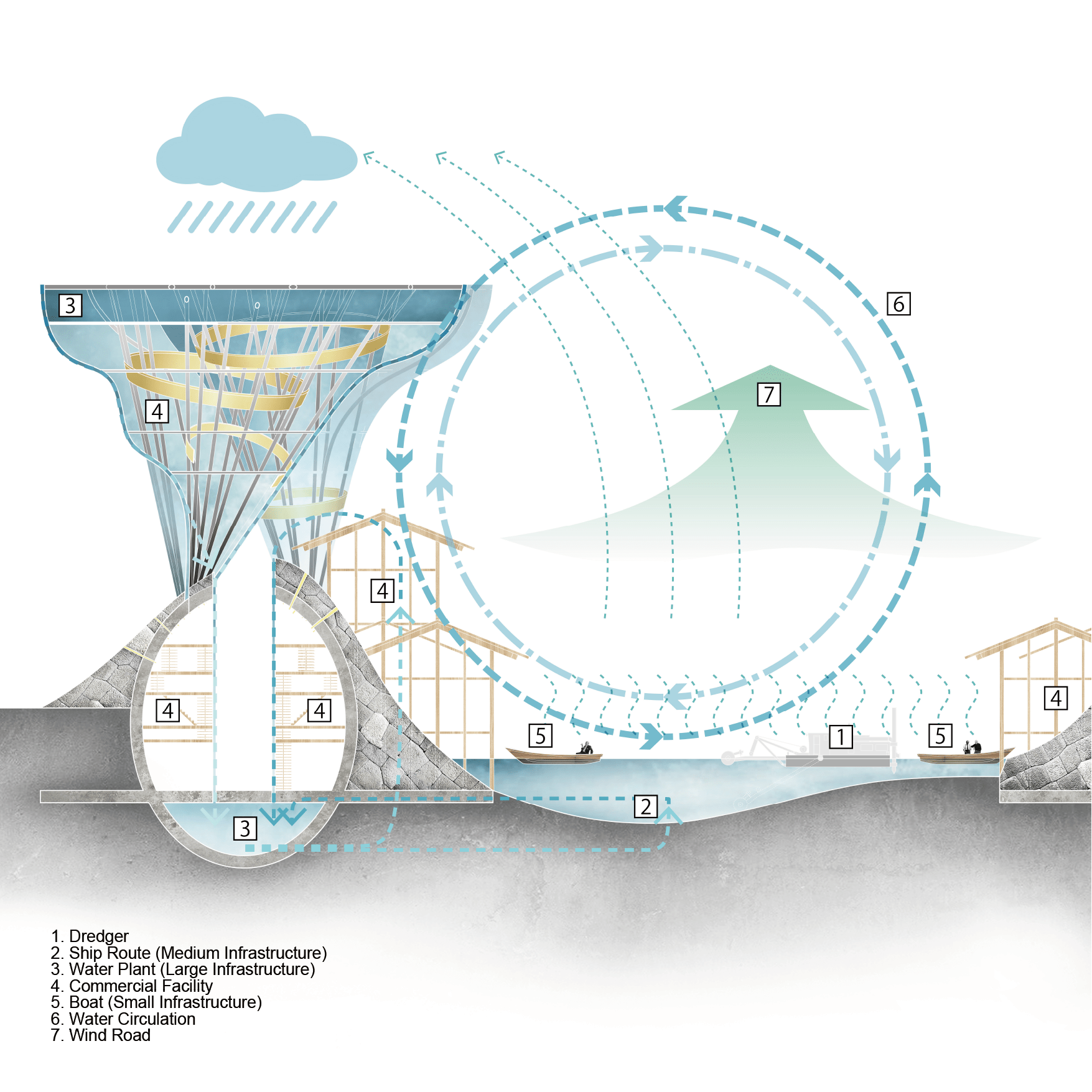
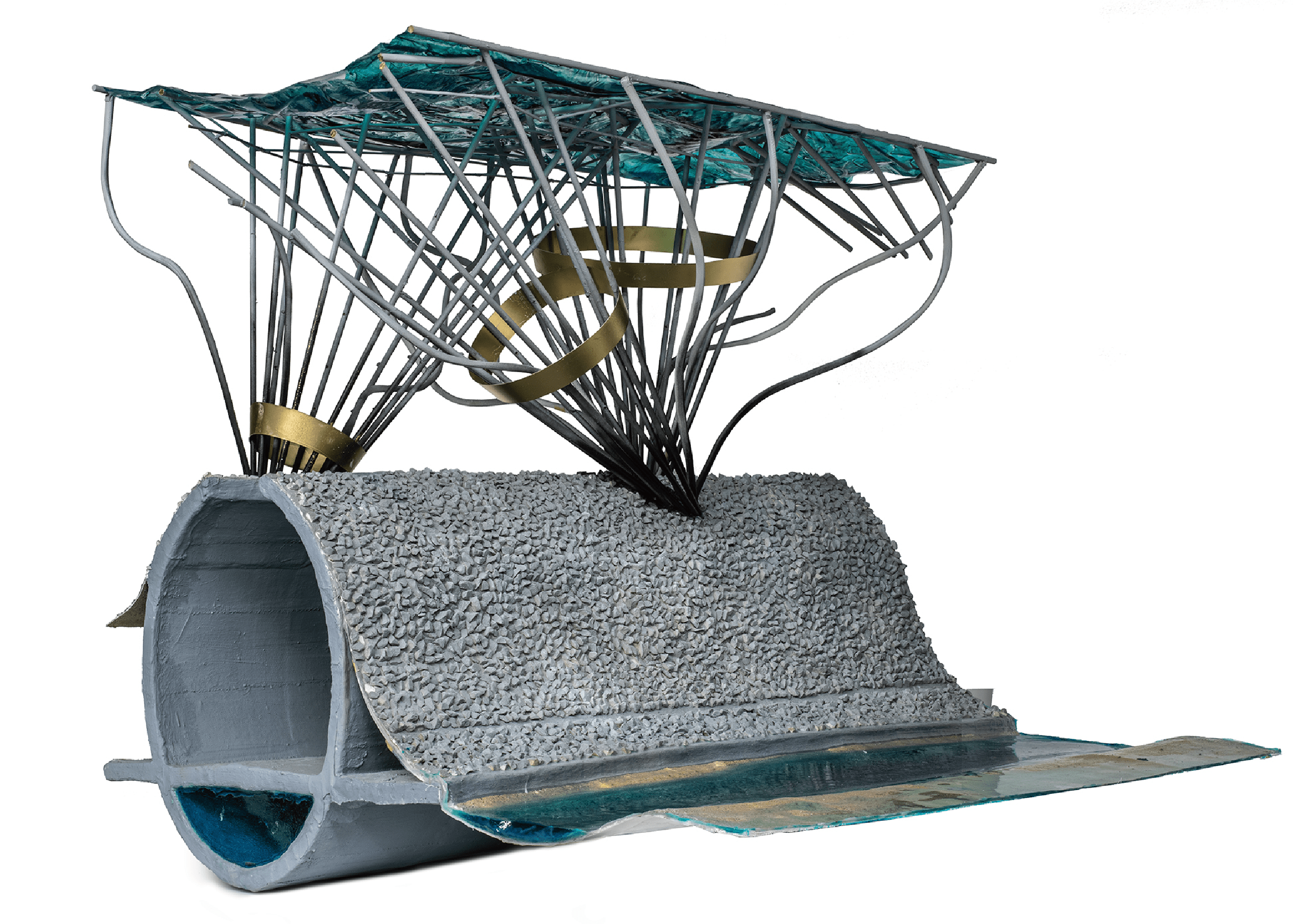
|
Space by the water of 3 large, middle and small infrastuctures
大・中・小3つのインフラが織りなす水際空間 |
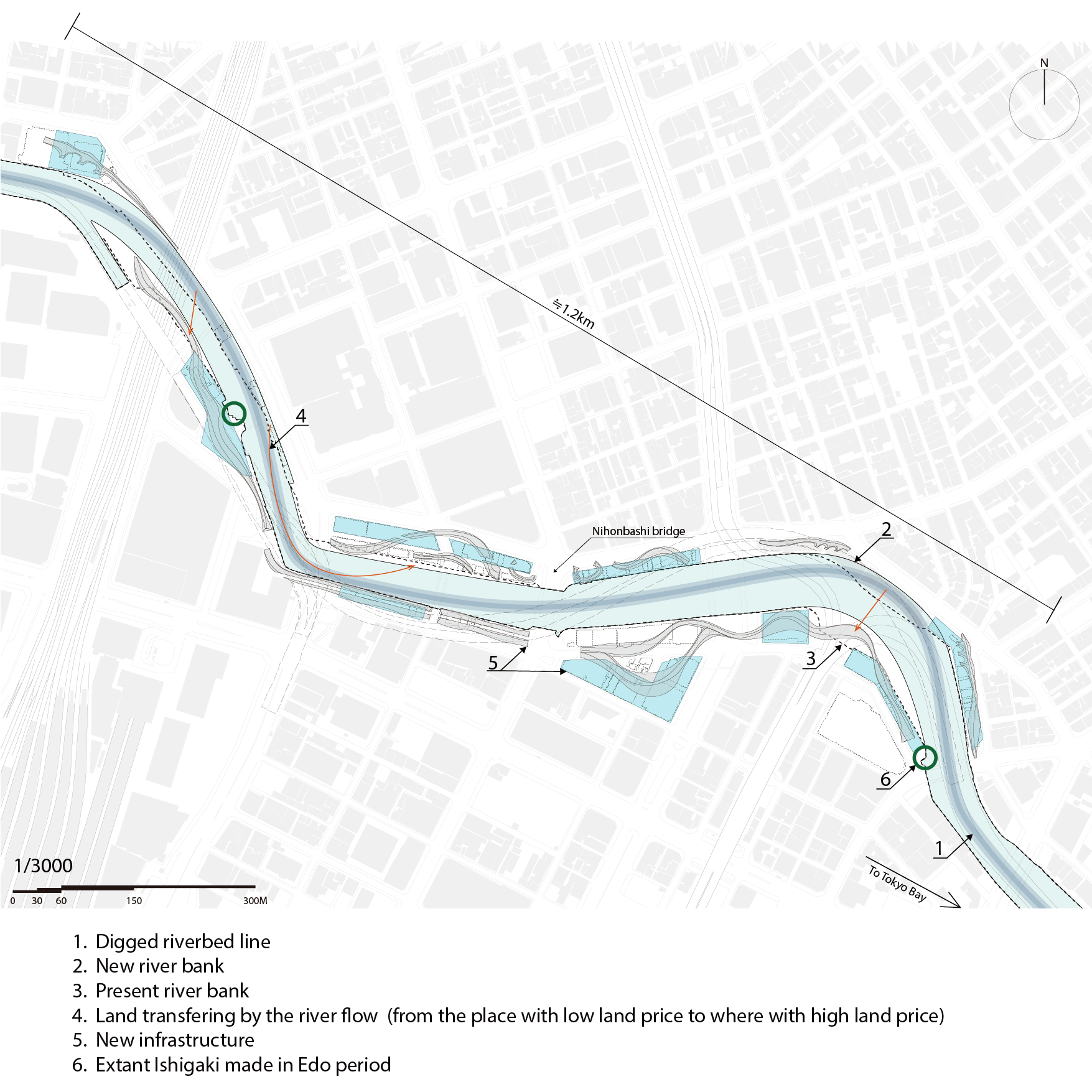
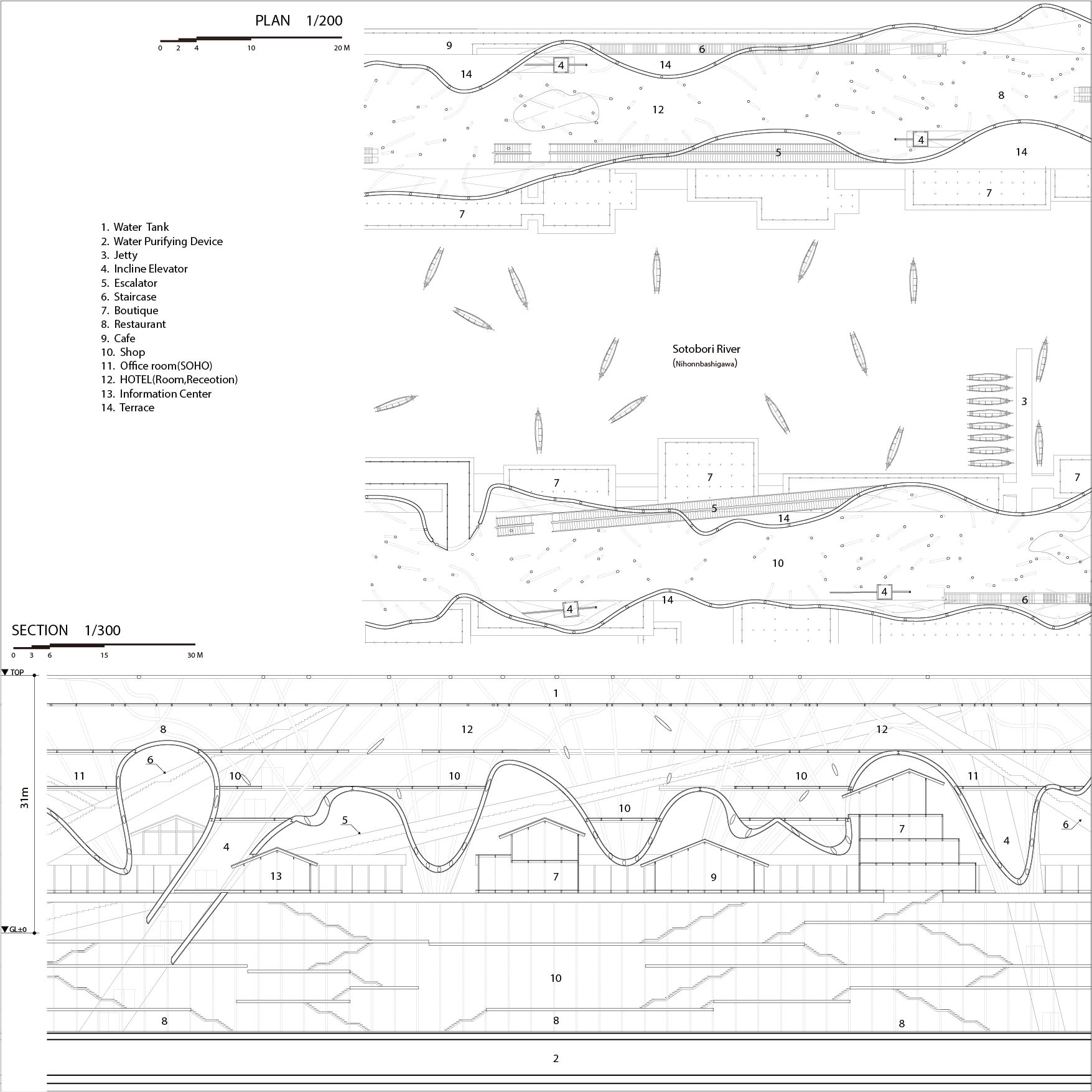
The water level keeps changing influenced by the tides due to the phases of the moon, and water in the Sotobori keeps altering the live hood and landscape of the waterside every moment.
Traveling on the water of Sotobori River by ship, passing under the Nihonbashi Bridge, the visual axis toward Imperial Palace and Edo Castle will appear again, and visual axis will also become a wind tunnel to let the wind from Tokyo Bay access to the center of the city.
月の満ち欠けによって干満の水位差の影響を受ける外濠の水は、その水辺の営みと景観を刻々と変化させる。
日本橋の下をくぐり、その水を行く船からは皇居と江戸城へのヴィスタが復活し、それはそのまま都市の中心に東京湾からの風を通す風洞となる。
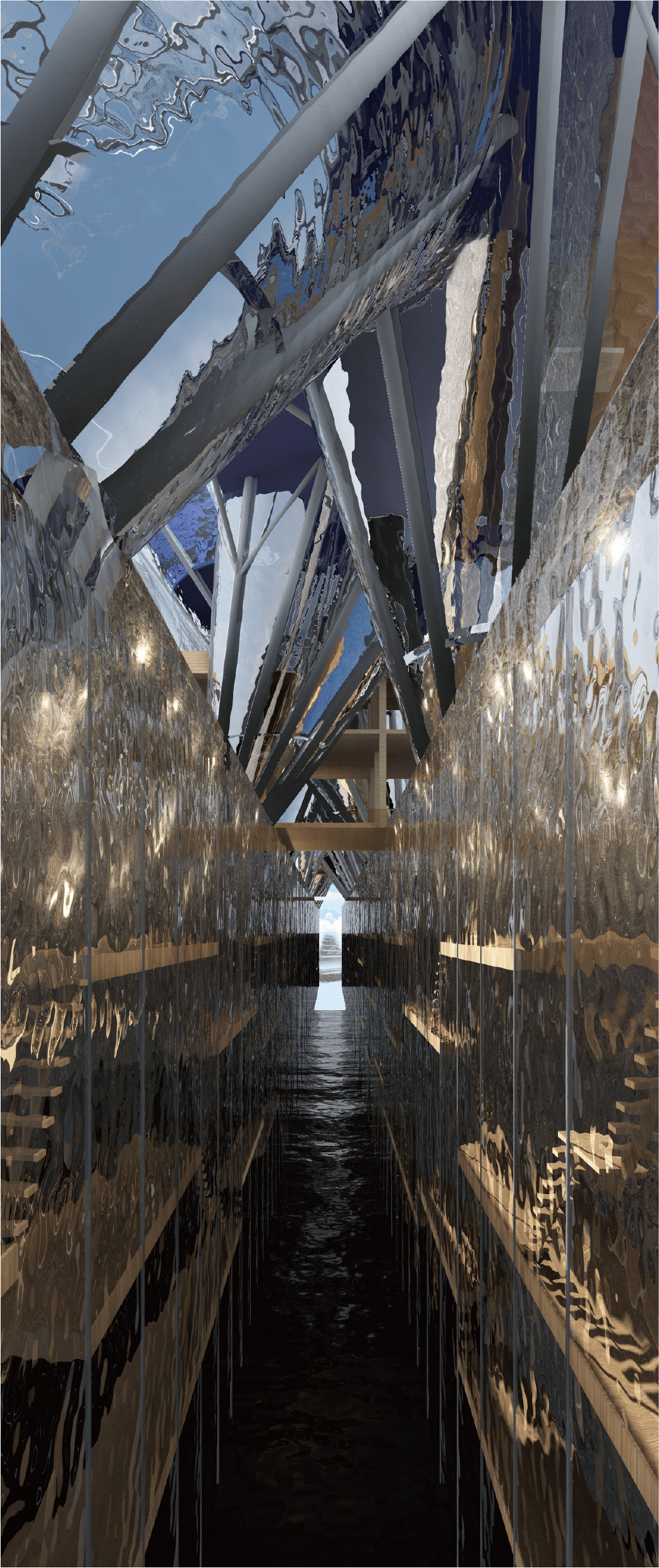
Interior of "Water Infra-Architecture".
A Silhouette of Edo Castle floats ahead of the gaze.
"Water Infra-Architecture"の内観
視線の先には江戸城のシルエットが浮かぶ。
早稲田大学創造理工学部建築学科 Waseda University School of Creative Science and Engineering Architecture
Copyright (C) 2014 Watanabe Taishi Laboratory, Department of Architecture, Waseda University. All Rights Reserved.